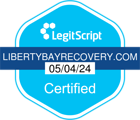Your Guide to a Xanax Withdrawal and Detox Program in Maine
Xanax is a strong benzodiazepine that’s primarily designed to treat anxiety and panic disorders. The potency of this drug is the main reason why people choose to use it differently than how it’s prescribed. Xanax works by enhancing neurotransmitters in your brain. This effect can make you feel considerably better than you did before taking the drug if you are in pain.
Over the past decade, Xanax addiction has become prevalent throughout the U.S. In a National Survey on Drug Use and Health, it was found that more than 30 million adults used benzodiazepines in a single year. While 25 million users took the medication as prescribed, more than 5 million misused the drug. Misuse counts for more than 17% of total use.
The most common form of misuse for Xanax and other benzodiazepines is taking the drug without a prescription. Many people who misuse the drug get it from a relative or friend. Keep in mind that using Xanax can lead to dependence even if you take it as prescribed. If you think that your body has become dependent on this drug, seek professional help through Xanax detox.
Significance of Xanax Detox
Xanax is a highly addictive substance that can lead to misuse even if you only take a large dose once. If you use this drug for a lengthy period, you’ll be at a higher risk for dependency. When your body becomes dependent on Xanax, it needs the drug to properly function. In this scenario, you’ll likely encounter withdrawal symptoms when you stop taking Xanax.
The risks associated with Xanax withdrawal involve mental health and physical symptoms. Some of these symptoms may be severe. Managing Xanax withdrawal often requires supervised detox. While some people attempt to perform unsupervised detox, there are several issues with this approach.
When the withdrawal process is supervised, you’ll receive 24/7 care from professionals who administer medication and know how to detect serious symptoms. Unsupervised detox takes place without medication and can be dangerous if a severe side effect occurs.
If you go through unsupervised detox, you’re more likely to relapse when the cravings hit. You may also develop post-acute withdrawal syndrome (PAWS). This condition can lead to additional symptoms that involve changes to your mood and cognition. PAWS can last for weeks or months. Medical supervision during Xanax detox reduces the likelihood that you’ll experience serious side effects while going through withdrawal.

Xanax Detoxification Methods: Exploring Options
There are several Xanax detoxification methods that you can receive when you want to stop taking the drug. Professionally supervised detox can take place at a hospital, residential facility, or outpatient facility. The main categories of Xanax detox include supervised and unsupervised methods. While unsupervised detox can include holistic approaches like eating the right foods and getting enough sleep at night, consider the supervised method.
There are two types of supervised detox, which include medication-assisted programs and social detox ones. Medication-assisted detox involves receiving medical monitoring and small doses of drugs that are designed to ease symptoms. These medications should stabilize you and help you get through the withdrawal process without experiencing too much discomfort.
As for social detox, it involves short-term support that doesn’t include medical supervision. If you enter one of these programs, you may receive interpersonal support in a safe and comfortable space.
Understanding Xanax Withdrawal Symptoms
When you stop taking Xanax, you may start to go through withdrawal symptoms. These symptoms are somewhat different for everyone. The most common ones include the following:
- Sweating
- Unintentional movements
- Restlessness
- Anxiety
- Insomnia
- Muscle pain
- Panic attacks
- Hand tremors
- Headaches
- Muscle spasms
- Nausea or vomiting
- Heart palpitations
- Seizures
- Hallucinations
You may also develop PAWS, which comes with a different set of symptoms. The most common symptoms of PAWS include the following:
- Anxiety
- Depression
- High stress sensitivity
- Irritation
- Cravings
- Difficulty learning anything new
- Memory issues
- Obsessive-compulsive behaviors
- Losing interest in your surroundings
While numerous strategies can be used to manage withdrawal discomfort, the one that’s employed most often involves medication. The various medications that are used to reduce withdrawal symptoms include the following:
- Methadone
- Clonidine
- Buprenorphine
- Over-the-counter medications
Choosing the Right Xanax Detox Program
When you decide to seek treatment, there are numerous Xanax detox centers to choose from. Individualized treatment plans are crucial to ensure that your specific needs are addressed. For example, people with co-occurring mental health disorders may require specialized treatment.
You should also consider whether you want treatment to be provided in an inpatient or outpatient setting. Inpatient detox often occurs at the start of a long-term treatment program. In comparison, outpatient detox can take place at many different facilities. Before entering a program, make sure the facility has the accreditation and credentials that prove that they specialize in Xanax detox. All healthcare providers who work there should have a certification or license as well.

Benefits of Professional Xanax Detox
There are numerous benefits of Xanax detox when your body is dependent on the drug. For example, obtaining detox before continuing treatment in an inpatient or outpatient facility should alleviate your withdrawal symptoms. Medically supervised Xanax detox also provides you with enhanced safety in comparison to self-detox attempts. You’ll be under medical supervision the entire time, which means that serious side effects can be prevented.
Keep in mind that some types of withdrawal are more difficult than others. Even if you don’t have cravings for Xanax during withdrawal, you might be tempted to take it because of the pain associated with some of the symptoms, which is why medical supervision may be necessary.
What to Expect During Xanax Detox
The Xanax detoxification process and timeline is straightforward. Xanax is a fast-acting drug, which means that it has a somewhat short half-life. The drug should be filtered out of your body quickly. You might begin to experience withdrawal symptoms within six to eight hours following your last dose.
The timeline of the withdrawal process varies based on the individual. If you adhere to the medically supervised schedule that involves tapering, the initial symptoms should peak after 48 hours. You may notice improvements to your symptoms by the fourth or fifth day. However, it can take anywhere from one to four weeks for the symptoms to go away entirely.
Xanax detox programs last as long as you need to get through the withdrawal symptoms. You’ll receive medical and psychological support throughout the detox process to make sure you’re coping well with the changes. Care is provided 24/7 by trained medical professionals.
Aftercare and Continued Support
While Xanax detox is important, it’s not meant to be a substitute for long-term treatment. Ongoing treatment can take place in inpatient and outpatient settings.

Inpatient treatment programs provide 24/7 supervision. The duration of an inpatient program depends on numerous factors. While it’s possible to complete this type of program in just a few weeks, it can also last for more than a year. The average stay in an inpatient facility is 28 days. However, the care providers at the inpatient treatment facility determine the right course of action.
Outpatient programs involve attending treatment for at least a few hours each week, which might allow you to meet your work and school responsibilities. However, there are several levels of outpatient treatment. If you enter an intensive outpatient (IOP) program, you may need to go to treatment around two to three days per week. Each treatment session can last for three to four hours.
Aftercare and ongoing treatment are often required for long-term recovery. There are numerous types of therapies that you can receive during treatment, which include everything from cognitive behavioral therapy (CBT) to motivational interviewing.
Cognitive behavioral therapy helps you understand the situations or thoughts that may be contributing to your substance use disorder.
Contingency management provides clients with incentives that may help them change specific behaviors positively. These incentives can include prizes, rewards, and other forms of positive reinforcement.
Empowering Recovery
Xanax detox is a crucial aspect of the recovery process for anyone who’s struggling with a substance use disorder that involves this drug. Because of how strong the drug is, it may be difficult to stop taking it unless you receive medical supervision while the withdrawal process is ongoing.
If you’re dependent on Xanax, seeking professional help can help you take proactive steps toward recovery and get your life back. Consider attending a treatment facility like Liberty Bay Recovery Center. We offer a blend of personalized care and evidence-based treatments. Our solutions include residential inpatient, intensive outpatient, partial hospitalization, and outpatient programs. Prioritize your health and well-being by entering a treatment program today.
RESOURCES
Addiction Recovery Blog
June 19, 2025
Addiction can significantly impact the entire family dynamic Roles shift routines change and relationships can...
May 19, 2025
The liver naturally detoxes your body but what happens when it s overwhelmed by substance...
February 16, 2025
Most people know that drinking too much alcohol can harm their health but many don...





